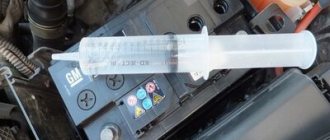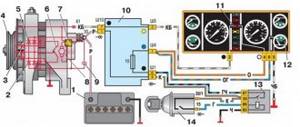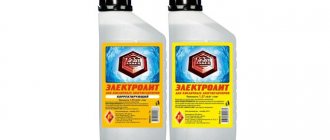The main problem when operating a car in winter is starting its engine at low temperatures. You can use autostart, autonomous and electric heaters. But if the battery cannot provide the starting current necessary to crank the starter, then all of the above becomes useless.
In recent years, the Internet community has begun to actively discuss the issues of protecting car batteries from frost and heat. The problem of starting the engine after parking the car in the cold season is familiar to many motorists. Therefore, on forums and blogs you can often see heated debates about the advisability of insulation itself and its options.
Any reactions inside the battery produce heat, and you can try to conserve this heat.
The developers of EPIC LLC asked themselves the question - maybe they could build a “fur coat” for the battery?
As a result of painstaking work, the “coat” for the battery took on a finished form and name – a thermal case.
Design and purpose of a thermal case for a battery
A thermal case is a heat-saving bag, a kind of thermos for a battery. Made of special, heat-insulating material, covered with chemically resistant fabric that is not corroded by battery acid.
Inside the thermal case, heat is retained with a cooling rate of only 0.7°C per hour.
The main purpose is to create and maintain favorable operating conditions (comfortable temperature from -15÷+30°C, safe storage, protection from damage and contamination).
In winter, when the engine is running on automatic heating at night, as well as during normal operation of the car during the day, a comfortable temperature is maintained inside the thermal case, allowing even a not very fresh battery to always produce the required starting current.
Well, in the summer the thermal case protects the battery from overheating.
One of the main manufacturers of thermal cases in Russia is EPIC LLC from Novosibirsk. Its products provide comprehensive battery protection against all potential problems.
Why do you need a thermal case?
Protection against sub-zero temperatures
At a temperature of -20°C and below, the battery experiences enormous difficulties in ensuring starter operation. Even the use of excellent oil in the engine does not ensure reliable engine starting.
It is important to understand that a cold battery does not charge well, and in severe frost there may be problems with normal charging in the car. This is especially true for urban vehicle operation with short journeys and long stops.
Constantly bringing the battery into a warm room while parked is troublesome and unsafe. Without a battery, alarm systems do not work and the car becomes easy prey for car thieves or thieves.
Numerous tests and experiments in real conditions of severe winter convincingly prove that a thermal case is an irreplaceable, simple and inexpensive solution for saving battery heat, but subject to certain conditions, which will be discussed below.
overheat protection
And you need a thermal case not only to protect the battery from frost, but also from heat.
When the battery is in the engine compartment, the part that faces the engine heats up more than the opposite part. Because of this, heated banks are charged better, while colder ones are undercharged.
Some craftsmen try to make thermal cases with their own hands, using various types of insulation, reflectors, etc. But often such “works of art” turn out unsuccessful.
The principle of operation of a thermal case - thermos
Let's try to understand the essence of the process in more detail.
A warm battery always turns the car engine better, because... chemical processes occur faster in it. Also, a heated battery takes charge many times faster than a cold one.
Let us describe a classic case from the lives of many of us. You come to the parking lot in the morning at -25°C, get into your car, start the engine (if possible). Warm up the car for 5-10 minutes and drive to work or about your business. The engine of your car has warmed up, but the battery is cold and it seems to be taking a charge.
Then you drive to work, turn off the engine and work quietly for 6-8-10 hours. In the evening, get into the car, turn on a bunch of additional equipment such as heated seats, rear, front windows, etc. This happens day after day and at some point the car refuses to start due to a dead battery.
The reason for a dead battery is quite simple: the current that the battery supplied to initially start the car was not compensated for during the trip and every day the battery loses capacity.
Often the generator cannot provide so much energy, plus you also turn on the dimensions and the radio. But the battery is cold and cannot be fully recharged, i.e. is in starvation mode.
In order for the battery to recharge normally, you need to drive for 40-60 minutes so that the engine compartment warms up and, accordingly, the battery becomes warm and begins to accept a charge normally.
That’s why it seems like they came up with thermal cases - we’ll put a battery in it, a positive temperature will be maintained and everything will be fine.
A thermal case is a heat-saving bag, a kind of thermos for a battery. Essentially, this is a soft bag (bag), inside of which reflective material is placed along all the walls. Those. prevents positive temperatures from passing out and negative temperatures from entering the case.
When making a cover for a thermal case, manufacturers use a special material – isolon. During testing, it was exposed to all sorts of known aggressive environments used in cars, including electrolyte.
It is very simple to check this statement - we take a little electrolyte from the battery with a hydrometer and drop it onto the thermal case.
There is no negative reaction to the electrolyte.
According to the developers, heat loss in the thermal case is only 0.7°C per hour.
At first glance, the idea is sound. But this is provided that you put the warm battery into a thermal case at home, closed it and installed it on the car. According to the laws of physics, due to thermal insulation inside the case, even in the cold there will be a positive temperature for some time.
Situation two - overnight at a temperature of -25°C, the thermal case, no matter how good it is, will cool down anyway. During a trip, the temperature in the engine compartment rises due to engine heating, and the battery in the thermal case (due to thermal insulation) still remains cold, since internal chemical reactions releasing heat are not enough to heat the battery.
A regular battery without thermal insulation would heat up during the trip and begin to accept charge from the generator well. But in a thermal case - no.
The thermal case works in two ways - it does not let heated air in and keeps cold air inside.
The manufacturers went further - they decided to add a heating element inside the thermal case.
Types of thermal cases for batteries
For uninterrupted operation of the battery at different temperatures, two types are offered:
- Thermal cover without heating. The thermos has a multi-layer design without a seam. Bottom – with insert. Made from modern materials.
- Heated thermal cover. It has low voltage plates built into it. They create heat inside the device, which is retained like a thermos in a thermal case.
PCB or plastic plates consume 20-40 W of energy and are located on the wide sides of the power source, which becomes warm and accepts charge well. You can easily change the parameters of the heating element. The dimensions of the plate, as well as the power, can be increased from 30% to 100% without any problems. This does not affect the electrical network of the machine.
Thermal case with heating plates
As you understand, the inventive idea was not limited to just the thermal case - after all, no matter how you keep warm, it is always not enough to maintain the battery in the most comfortable temperature regime for it.
Below you can see the battery heating system.
It makes no sense to constantly heat the battery, so the built-in thermostat turns off the heating when it reaches +25°C and turns it on again at -5°C.
While finalizing the design, numerous temperature measurements were taken inside the thermal case at different outside temperatures and under different travel conditions. At the same time, the temperature inside the case practically did not drop below -10°C, and often remained above 0°C.
At this temperature, even a tired battery is quite capable of providing the necessary starting current.
The plates heat the battery inside the thermal case. They consume approximately 30 W and only start after the engine has started.
A special electrical relay “sees” when the voltage in the vehicle’s on-board network is greater than 13.8 V. After this, the plates around the battery begin to heat up. Accordingly, the temperature inside the case also begins to rise. In just a couple of minutes the temperature rises to +15°C.
These are very comfortable conditions for the battery to operate; it quickly begins to take charge and replenishes the energy reserves that were spent on starting the engine.
Only with such plates does it make practical sense to use a thermal case.
Do-it-yourself thermal case for a heated battery
There are many ways to warm up the battery while the engine is running, but when the on-board system is asleep and there is not even auto start, the battery will be saved from freezing by a high charge level. Up to -20 0, a serviceable battery should easily overcome starting difficulties.
How to arrange heating for a battery? Is it possible to create a thermal case with your own hands, or are there other ways to protect the battery? It should be immediately noted that the warm casing on the battery works like a thermos. But it only retains heat or cold inside a closed space and prevents temperature changes.
- Sew a casing made of fur coat, felt or special insulation onto the battery case. If the car is actively used during the day with short downtimes, the fur coat will retain heat well in the battery.
- Insulating the engine compartment will retain heat from the engine, the oil will not thicken, and the injector and air filter will be warm. Starting a warm system will take less energy from a warm battery. Starting the engine in the morning is easy.
- You can heat the battery from the stove, which is heated by the circulation of antifreeze. You can make a tap - a loop to the battery.
- Heating of the battery with resistances from the on-board network with the installation of an insulating circuit made of polystyrene foam.
- Instead of resistances, you can use nichrome thread. The element is used in heating car seats.
Installing a thermal case on a car
The size of the thermal case depends on the size of the battery. European traditions of engine compartment layout differ from Japanese ones. In most Japanese cars, especially those of the late 20th - early 21st centuries, the layout is simpler and the thermal case is installed without problems.
Thermal cases for small batteries (passenger cars)
Using this table, you can select not only the dimensions of the thermal case depending on the capacity and battery case, but also determine the approximate cost.
There is nothing complicated when installing a thermal case on domestic cars, such as early classics. The battery is placed in a case, heating plates are inserted along the long sides. The unit with the thermostat is placed in a case along one of the short sides of the battery.
The thermal case is fixed in its regular place and connected with cables to the on-board network. The thermal relay wires are attached between the battery terminals and the mounting nuts.
After installing all the wires, you must carefully check the tightness of the terminals.
The lid is attached to the top of the thermal case with Velcro.
You can buy the thermal case separately or in a set with heating plates and other additional elements.
The manufacturer advertises the following positive properties of thermal cases:
- — protection of the battery from mechanical impact, dirt and dust;
- — protection from exposure to aggressive environments (electrolyte, brake fluid, gasoline, antifreeze, fire, etc.);
- — providing protection against thermal shocks (hypothermia and overheating) during the entire period of operation of the car battery;
- — slowing down the cooling time of the battery for the period when the heating plates are turned off;
- — heating the battery to a positive temperature before starting the engine.
How to insulate a battery yourself
There are two methods for insulating batteries:
- make a thermal case with your own hands;
- make a battery heating system.
DIY thermal case
To make your own cases you can use:
From foam plastic
Assembly Guide:
- At the first stage, it is necessary to select a material of appropriate size and thickness. It is not recommended to make a thermal case from foam that is too thick (more than 3.5 mm).
- The material is used to make a box in which the battery will be placed. Using a stationery knife, you need to cut out the walls, lower and upper parts of the structure. All components can be connected to each other using glue. At this stage, you need to pay attention to the joints and seams - they should be additionally treated with sealant.
- The car battery is installed in the case, after which the structure can be covered with a lid. It is necessary to make holes through which the terminals with cables exit. It is important that they are not too large, otherwise the battery will cool down very quickly.
Insulation with foil insulation
Folgoizol is a comfortable and flexible material that allows for high-quality heat retention. To make the thermal case work more efficiently, three layers of material can be used in the base.
Instructions for assembling the thermal case:
- First, measurements are taken of the case, which must correspond to the dimensions of the battery.
- An insulating material is taken from which the walls for the thermal case need to be cut. You can cut foil insulation with a stationery knife or scissors.
- By analogy with the manufacture of a foam product, the walls, bottom and top cover are cut out. This material is recommended to be used additionally as a middle layer of protection. It is desirable that the thickness of the foam is no more than 2 cm.
- The walls for the case are also cut out from foil insulation, only now you need to make the components for the outer layer of insulation.
- Fixation of foam walls is carried out using glue, and foil walls are fixed with tape. This is what you need to do with the lid and lower part.
- The battery is placed in the thermal case; you need to make sure that the overall dimensions of the devices match.
Felt case
In this case, the principle of insulating the battery is similar to that described above - the car owner needs to make a case or bag from felt.
Points to consider:
- to ensure maximum effect, it is better to fold the material in several layers;
- Felt insulation allows you to keep the device warm for 8 hours;
- this method has proven itself in practice if the car is used daily;
- The main disadvantage of such devices is that after starting the engine, heat will flow to the battery with difficulty.
Video: how to make a thermal case from felt with your own hands?
Taken by user Alexander.
How to warm up a battery
For the manufacture of a battery heater, the following may be used:
- Antifreeze. The main advantage is the quick warm-up of the engine and ease of maintenance of the system. The main disadvantage is the complexity of connection on individual cars and the possibility of leakage of consumables.
- Nichrome thread. The main advantage of this method is the speed of implementation and the absence of difficulties in finding material. The disadvantage is that the battery takes a long time to warm up.
- Resistance from the machine's on-board network. The complexity of the method lies in its implementation - only a specialist can cope with such a task. If desired, you can add an additional sensor that will control the operation of the heater.
Heating with coolant
To heat the battery, a branch in the form of a hose is made from any point in the cooling system, which is then laid around the battery. Additionally, the pipe is wrapped with a rag (in this case, the antifreeze itself will act as insulation).
Using powerful resistors from the on-board network
Features of operating the on-board network of the machine for heating the battery:
- The heating principle is based on the use of additional resistances; these components must be assembled in a series circuit. When connecting in parallel, the nominal resistance must be selected taking into account the current level and the desired heating temperature. The higher the operating parameter, the more effective the heating will be.
- An additional controller can be added to the circuit, which will be used to open electrical circuits and reduce the battery voltage. The resulting supply of capacity is enough to start the engine in the morning.
- It is possible to implement another method with resistance, in which the battery will not discharge if the engine is not running. To do this, you will need an additional battery that will power an electrical circuit that includes several resistances. It is advisable to use AGM batteries.
- If it is necessary to provide the ability to control the heating system using a toggle switch, then the device activation button can be brought into the cabin. This method makes it possible to heat the device from the inside so that the resulting energy is used for external heating.
Heating using nichrome thread
The heating system is made from nichrome thread by analogy with the method that uses powerful resistance from the on-board network. The main difference is that the function of the heating system falls on the nichrome material, which must be connected to the electrical network instead of resistance.
- The thread can be wrapped in plastic, PVC, or other material that has insulating properties.
- The length and cross-section of the nichrome thread are selected taking into account the power level of the heater. If you need to increase this parameter, you can use several layers of material and wrap them around the battery.










